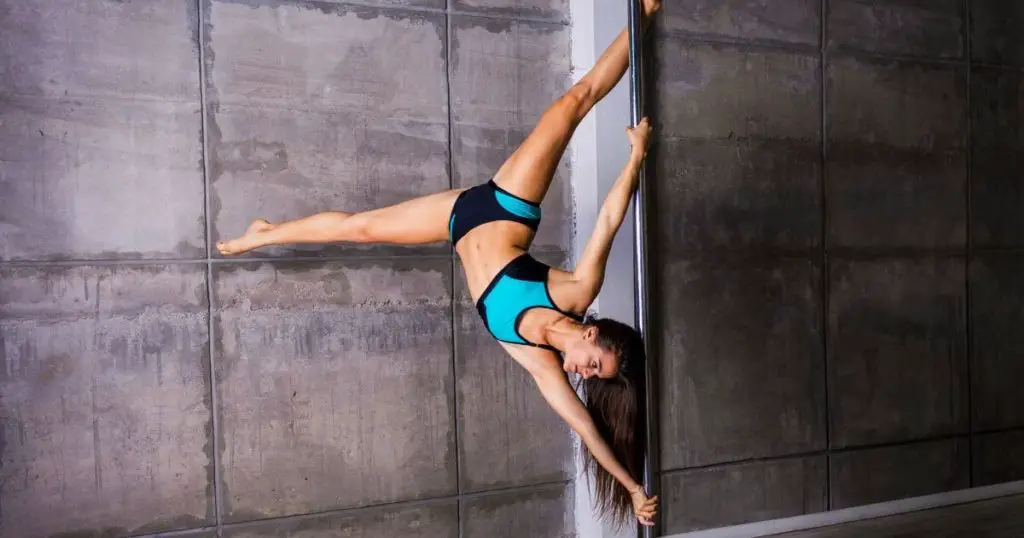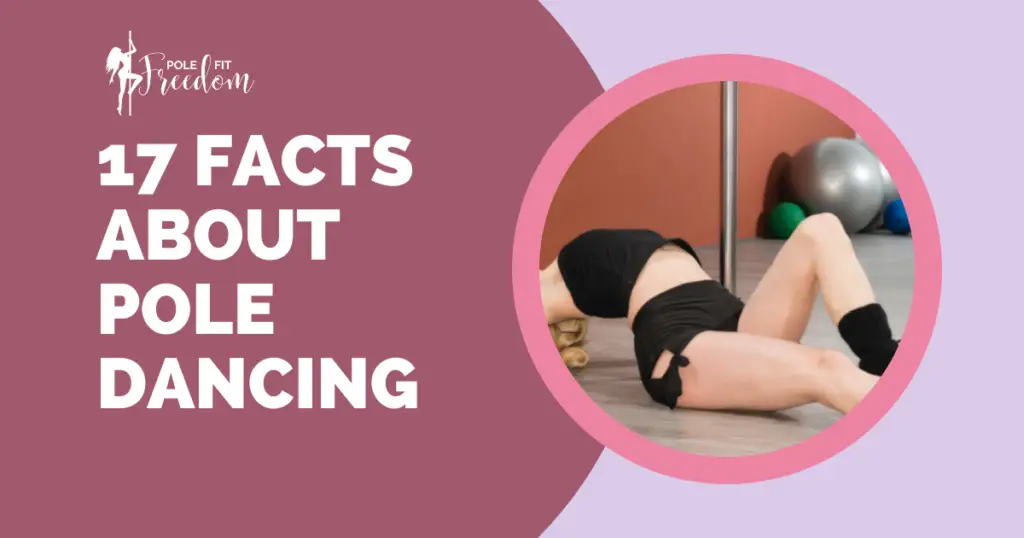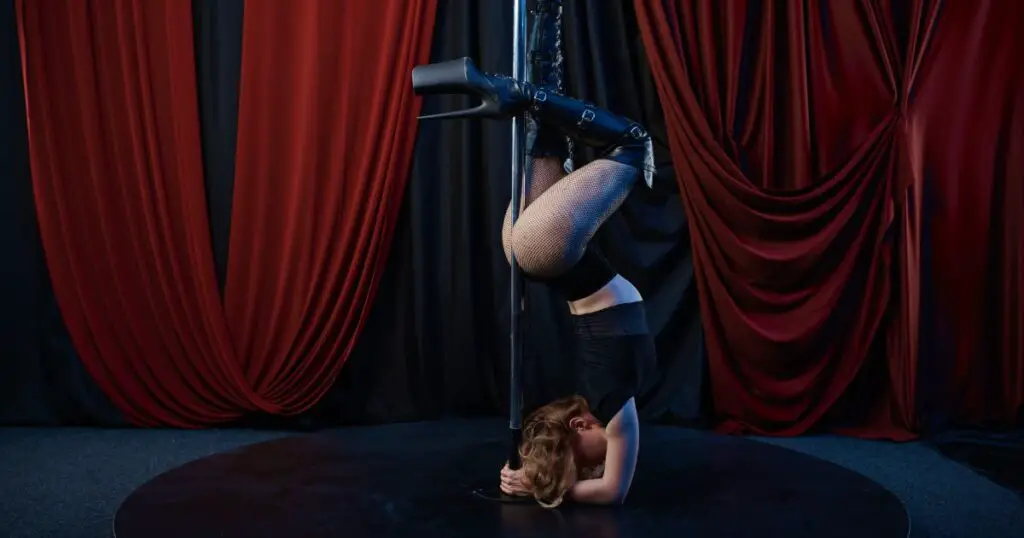Are you curious about the physics of pole dancing? Look no further! In this blog post, we will introduce the scientific principles at play in this impressive and graceful art form.
From the forces that keep a pole dancer suspended in mid-air to the principles of torque and angular momentum, we will shed light on the fascinating world of pole dancing physics.
So grab a cup of coffee and let’s dive in!
Note: we are pole dancers, not scientists. Although, our chief editor has a degree in Computer Science, she is not an expert in physics. All the references are linked at the end of this article.
Centrifugal Force and Spinning
When you use a spinning pole, the speed of rotation gets faster the closer you are to the centre of the axis. This is called centrifugal force.
For example, when you’re spinning on the pole, they use their body position and the pole’s rotational inertia to generate the necessary centripetal force to keep you moving in a circular path. [1, 2]
Also, if you’re spinning on the pole and your body is very close to the pole, such as a fireman or a spinning climb, you will be spinning faster.
Tricks such as Extended Butterfly, Flatline Scorpio or Superwoman will mean that you will spin slower, as your body is stretched wide and is further away from the pole.
See also: How do pole dancers stay on the pole?
Lines and Angles
Many pole tricks that require split grip, either inverted or the “right way up”, often rely on having your hands in the correct position.
If your hands are in the wrong position, either too close together or too far apart, then the angle of your body is wrong, meaning less control.
A good instructor will be able to tell when your lines or angles are wrong and can correct you. Picking up bad habits can lead to unsafe practice, so make sure your angles are perfect!

Use a camera on a tripod to record yourself and check your own lines if you practice at home!
Speed, Distance & Time
Let’s get nerdy for a bit…
Speed, distance, and time are all directly related to each other. Speed is a measure of how fast you are moving, distance is a measure of how far you have traveled, and time is a measure of the amount of time that has passed. The formula for calculating speed is speed = distance / time.
This means that the faster you are moving, the greater the distance you will cover in a given amount of time, and vice versa. Additionally, the longer you’re spinning for, the greater the distance you will cover, regardless of its speed.
So, what has this got to do with pole dancing?
Everything!
Speed, distance and time in pole dancing is what makes the choreography of your performance memorable, dramatic and causes true shock and awe from the audience.
You can use speed, duration and time in your routines for dramatic effect, to build tension or show off your sexuality.
See also: Do Stripper Poles Spin By Themselves?
Push & Pull Forces
Another principle of physics that applies to pole dancing is force.
Force is a push or a pull that can cause an object (in this case – you!) to accelerate.
When you’re learning how to pole dance, you’ll notice that many of the tricks or static poses involve pushing with one arm and pulling with the other.
It is these opposite forces that help your body stay up on the pole. Your upper body strength determines the total force exuded on the pole. [3]
In pole dancing, force is also used to move, spin, and invert on the pole, and it is an essential element of many pole dancing techniques.
For example, when you pull yourself up the pole, you are using their arm and leg muscles to generate force, which allows you to overcome the force of gravity and lift your body off the ground.
Forces That Can Defy Gravity
Pole dancing involves a variety of acrobatic maneuvers that may appear to defy gravity.
However, these maneuvers are actually made possible by a combination of factors, including the dancer’s strength, body position, and use of the pole.
One way that pole dancers are able to defy gravity is by using their own body weight to generate the necessary forces.
When a dancer wraps their legs around the pole and pulls themselves up, they are using their own weight to generate a downward force on the pole.
This downward force is counteracted by an equal and opposite upward force, known as the normal force, which is provided by the pole.
Additionally, pole dancers use their own body position and the properties of the pole to generate different levels of force.
See also: Tips for male pole dancers
Want to become an amazing pole dancer?
Open Dance Academy has over 450 online lessons, by some world famous pole dancing champions! Join now to get:
***GET 10% OFF OPEN DANCE ACADEMY***
Use the code polefitfreedom to get 10% off Pole Dancing Lessons with Open Dance Academy. This is an exclusive offer for readers of this blog!
Conclusion: The Physics of Pole Dancing
In conclusion, pole dancing is an impressive and graceful art form that involves a complex interplay of physical forces and movements.
From the forces that keep a pole dancer suspended in mid-air to the principles of torque and angular momentum, the physics of pole dancing is fascinating and well worth exploring.
We hope that this blog post has helped to shed some light on the scientific principles at play in pole dancing, and perhaps even sparked your interest in the physics of other acrobatic disciplines.
Thank you for reading!
References
- Rotational inertia: https://www.khanacademy.org/science/physics/torque-angular-momentum/torque-tutorial/a/rotational-inertia
- Rotation of an Object About a Fixed Axis: https://www2.tntech.edu/leap/murdock/books/v2chap1.pdf
- Nicholas JC, McDonald KA, Peeling P, Jackson B, Dimmock JA, Alderson JA, Donnelly CJ. Pole Dancing for Fitness: The Physiological and Metabolic Demand of a 60-Minute Class. J Strength Cond Res. 2019 Oct;33(10):2704-2710.






